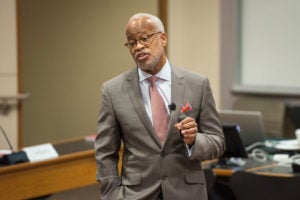Report on Stanford’s undergraduate education
Stanford is working to better support undergraduate students, including through additional resources for first-generation students, new first-year learning opportunities, strengthening the advising program and more attention to student health and well-being.
“Our students have abundant opportunities here. We want students to find their own definition of Stanford,” said Senior Vice Provost for Education Harry Elam, who recently delivered his annual report on undergraduate education to the Faculty Senate. However, he said, undergraduate students need support and guidance as they chart their academic pathways.
Elam highlighted key programs and initiatives for supporting Stanford’s 7,062 undergraduate students. He focused on issues in the areas of academic choices, health and well-being, and access and equity.
Elam said that as the undergraduate population continues to become more diverse, Stanford must ensure access for students of all backgrounds.
“Admissions has done an incredible job in bringing us a diverse and talented array of students. But we’ve not yet done an adequate job of ensuring that each of our students are fully supported and guided according to their needs,” he said.
Elam said the university continues looking for ways to expand and enhance resources for students who are the first in their families to attend college and students from under-resourced high schools. He said that the most recently admitted class has the highest proportion – more than 18 percent – of first-generation college students in Stanford’s history.
One Stanford initiative to support first-generation students is the summer Leland Scholars Program (LSP), which helps students prepare both socially and academically for college.
The program has expanded to accommodate 60 students, though more than 140 students applied for the summer 2017 session.
“LSP on its own is not enough. We have to do more for these students as they negotiate Stanford,” said Elam.
Humanities and Sciences Dean Richard Saller is leading a task force charged with assessing support for Stanford’s first-generation and low-income students. The committee is taking stock of programs and services currently offered for these students to find where there may be gaps.
Elam noted that, given the many opportunities offered at Stanford, undergraduate students often struggle with making choices. Advising is a key component in assisting students in this process.
Plans to strengthen the advising program include increasing the number of professional advisers and boosting online resources for students. Stanford also recently launched the Stanford Newcomer Guides mentor program, which is designed to complement and support academic advising.
The first-year experience is another area that is receiving more attention, Elam said.
“What has become increasingly clear to me is that first-year education needs to be more holistic, intentionally integrating the learning that happens both inside and outside of the classroom,” said Elam.
He noted that issues of health and well-being greatly impact learning for first-year students, and Stanford is developing programs to address this.
One of those is Frosh 101, a pilot program that was offered at five student residences beginning in fall 2017. The program, which received positive reaction from participants, is designed to help students with the transition to college and focuses on issues of belonging, identity and community. In fall 2018, Frosh 101 will expand to 10 dorms with an anticipated participation of 300 students, Elam said.

